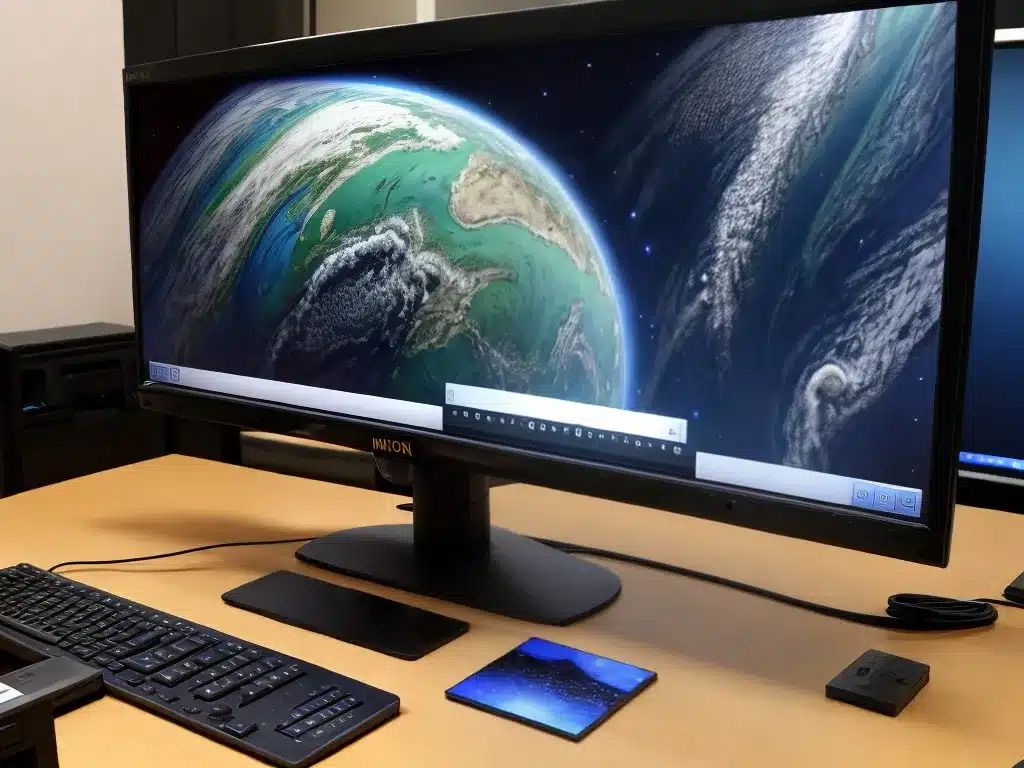
I recently ran into an issue where my monitor suddenly stopped displaying anything. A blank, black screen can be incredibly frustrating and make you feel helpless. However, there are a number of things you can try on your own to get your monitor working again before you resort to taking it into a repair shop or buying a new one.
Troubleshoot Display Connections
The first thing to check whenever your monitor goes blank is the physical cable connections between your monitor and computer.
Check Video Cable
Make sure the video cable running from the back of your computer to your monitor is securely plugged in at both ends. Video cables can sometimes become slightly loose over time from moving your monitor or computer, so checking this is a quick fix. If the cable is loose, firmly push it all the way into the ports on both devices.
Use the correct type of video cable for your monitor. Most modern monitors use HDMI or DisplayPort, while older VGA ports are becoming less common. If you recently upgraded your monitor, you may need to use a different video cable than before.
Check Power Cable
Like the video cable, your monitor’s power cable can also become loose and prevent your monitor from turning on. Check that the power cable is firmly connected to both the wall outlet and monitor power port.
You can test the outlet by plugging in another device like a lamp. Try using another power cable if you have one available. Faulty power cables are a common culprit for monitor display issues.
Switch Video Inputs
Your monitor may have multiple HDMI, DisplayPort, or other inputs that you can switch between. Make sure the input selected on your monitor matches the video connection from your computer. Press the input button on your monitor to cycle through the options until you see your computer desktop displayed.
If you recently connected a new device like a game console, the monitor may have defaulted to that input instead of your computer. Switching the input back should restore your monitor’s display.
Check Display Settings
If the monitor connections seem fine, the next place to check is your display settings in Windows.
Adjust Resolution
Lower video resolutions like 800×600 are more likely to work than very high resolutions. Reset your computer’s screen resolution to a basic setting as troubleshooting.
On Windows 10, right-click your desktop and select Display Settings > Display Resolution . Move the slider to a lower resolution like 1280×720 and click Apply. Then try increasing back to your normal resolution.
Update Graphics Drivers
Outdated graphics drivers can cause display issues with monitors. Go to your graphics card manufacturer’s website (Nvidia, AMD, Intel etc) and download the latest drivers. Install these drivers and restart your computer.
Detect Displays
If your monitor is not detected at all, go to Display Settings and click Detect. Windows should automatically detect connected monitors and enable you to set resolutions.
If you have multiple monitors connected, make sure the correct one is set as the primary display. The primary display is where your desktop icons and taskbar will appear.
Check Monitor Settings
If display settings changes don’t help, your monitor’s onboard menu may also have options to change.
Factory Reset
Resetting your monitor to factory default settings can fix software-related issues. Look for a “Reset” or “Factory” button in your monitor’s on-screen menu. This will undo any setting changes that may be causing problems.
Enable Auto-Detect
Many monitors have an auto-detect or auto-configure setting that automatically adjusts to receive the incoming video signal. Browse your monitor menu for this option.
Adjust Brightness/Contrast
Make sure the brightness and contrast are turned up on your monitor. This likely won’t fix the black screen problem, but it’s worth trying. You may at least see a faint image.
Hard Reset Monitor and Computer
If you’ve tried all other steps, perform a hard reset by disconnecting power to both devices:
- Shut down your computer and turn off the monitor.
- Unplug the power cables from both the monitor and computer.
- Press and hold your computer’s power button for 15 seconds to discharge residual power.
- Reconnect the power cables and turn both devices back on.
This forces the monitor and graphics card to re-initialize, which can correct software conflicts.
Contact Manufacturer Support
If you still can’t get your monitor to display after trying these steps, it likely requires professional repair or replacement:
-
Contact the monitor manufacturer’s tech support online or by phone. They can help diagnose hardware failures and arrange RMA (return merchandise authorization) if needed.
-
Take your monitor to a repair shop for testing. They have tools to diagnose problems and may be able to replace internal components like fuses and capacitors.
-
Consider buying a new, replacement monitor with an equivalent or better specification. Prices for LCD monitors have fallen and you can often find good deals.
A blank monitor is very inconvenient but there are steps you can take to get it working again. Start with simple connection checks and then move to software settings. Reset both devices if needed. Seek professional help to test hardware issues. And finally, replacement can be an affordable option for upgrading your display.












